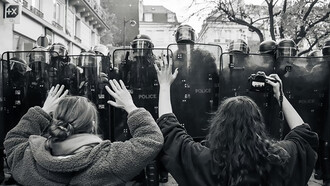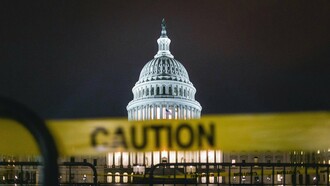Major symptoms of narcissist personality disorder are the need to control/dominate others and feel a sense of superiority. When a group of people fears what they term as “replacement”, a threat to their sense of superiority or loss of power to control and dominate, this is an indication of “collective narcissism”.
The Diagnostic and Statistical Manual for Mental Disorders describes several behaviors associated with a narcissist personality disorder. These same behaviors are consistent with the emotional needs and behaviors exhibited by an attachment to the social construction of “whiteness”. Here's a comprehensive list of those behaviors:
- A grandiose logic of self-importance that justifies one’s right to control and dominate others, an obsession with power.
- A fixation with fantasies of unlimited success, control, etc., or distorted reality is evident by an insistence on social, political, and economic inequality.
- A credence that he or she is extraordinary or exceptional based upon the mythology of white superiority.
- A desire for unwarranted admiration is demonstrated by the need for a phobic object who is submissive, subservient, and knows his or her “place” on the racial hierarchy.
- A sense of entitlement is exhibited by the demand for unequal opportunities in all dimensions of life.
- No form of empathy, a core aspect of attachment to the social construction of whiteness, indifferent to the suffering of others ability to exploit, engage in humiliating, inhumane, and violent aggression toward those designated as the “other”.
- Resentment of others demonstrated by racial terrorism toward individuals and communities that refute the mythology of white superiority by attaining land and wealth that outmatches whites.
- Inability to accept criticism, exhibited by defensiveness, projection, and blaming the victim for racial atrocities.
The Jim Crow era is an example of the response of collective narcissism. The Jim Crow era was created as a reaction to the freedoms enjoyed by blacks during Reconstruction. It restored the conditions that created a sense of white superiority. It was a system that was undergirded by the beliefs or rationalizations that whites were superior to blacks in all ways in terms of intelligence, culture, and morality.
To ensure domination and control of blacks, laws were created which put in place structural oppression that empowered and privileged those designated as white while segregating, discriminating, and violently abusing blacks. Jim Crow Laws were instituted by states to ensure white “place” at the apex of the racial hierarchy.
Collective narcissism was reinforced by U.S. Supreme Court decisions such as the 1883 repeal of the Civil Rights Act of 1875, and the 1896 Plessy decision. These laws ensured no social, political, or economic equality as racial “inequality” and white domination were hallmarks of the invention of whiteness. Whites could feel a sense of superiority when they saw a “Whites Only” sign or “Colored” bathrooms and entrances to waiting rooms. They felt superior when blacks had to wait until whites entered public transportation and had to take seats in the rear. Black prohibition from public parks, swimming pools and other public facilities further enhanced the sense of white superiority.
Segregated and discriminatory economic practices, i.e., last hired and first fired, as well as the denotation of “colored “jobs, and exploitative working conditions and pay reinforced the sense of superiority and entitlement as well as the inequality promised to those with white skin.
A dominant behavior exhibited by narcissism is the need for admiration and submission from those designated as inferior. Jim Crow customs or etiquette ensured the submission of blacks. “Knowing their place” was crucial during the Jim Crow era. Blacks had to overtly submit to demeaning actions, and humiliation without indicating any displeasure with the behavior of whites. The deferential behavior expected of blacks in terms of mannerisms, speech, and even posture confirmed white superiority and the power that went with it. Blacks who forgot their place were punished and even murdered. Related to this aspect of collective narcissism was the resentment and envy of black progress. The destruction of black towns and communities such as Tulsa were exhibitions of narcissist envy.
The lack of empathy, a core component of narcissistic personality disorder was blatantly exhibited with the inhumane treatment of blacks, especially racial violence toward and the lynching of blacks. Racially related inhumanity and brutality were key elements of the collective narcissism displayed during the Jim Crow era. In the cases of racial terrorism toward blacks, the victims of the attacks were blamed. The psychological mechanism of projection was used by whites engaging in racial violence toward blacks. They attributed their unacceptable impulses and motives to black individuals. Stereotypes of the “Black Brute” as aggressive, savage, and violent made it easy to conveniently deflect blame from whites onto black victims of racial violence.
Digging deeper only allows more questions to surface. To what extent does collective narcissism influence racial thought and relations in the United States today? Are segments of whites feeling the same obsessive fear and resentment that occurred after Reconstruction? Are there aspects of collective narcissism being displayed by a segment of whites during this “post-racial” era? What aspects are most prominent? Is it possible that collective narcissism becomes the norm in the United States again? Is it possible that laws can be changed and created that will once again limit the equality and rights of those not designated as white? What is necessary for whites exhibiting behaviors associated with a narcissistic personality disorder to confront and challenge the need for those behaviors?














